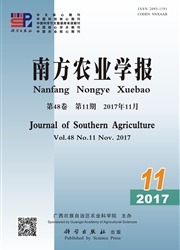

 中文摘要:
中文摘要:
【目的】了解天门冬氨酸氨基转移酶(AST)、白蛋白(ALB)、尿酸(UA)等血液生化指标在奶牛产后的变化特征及彼此间的相关性,为奶牛产后健康养殖及疾病检测提供参考依据。【方法】随机选取广西南宁某奶牛场荷斯坦奶牛35头,分别于分娩当天及产后第14、28、42、56d清晨空腹颈静脉采血,离心获得血浆后测定AST活性及ALB、uA水平,并进行Pearson相关分析。【结果】奶牛血浆AST活性在产后急剧上升,于产后第14d达峰值(84.27±15.10U/L);而ALB含量在产后快速降低,于产后第14d降至最低值(36.51±2.27g/L);UA浓度于产后第14-28d急剧上升,第28d上升至峰值(80.70±8.06μmol/L)。相关性分析结果表明,AST活性与uA浓度分别在分娩当天及产后第28、56d呈显著正相关(P〈0.05),AST与ALB在产后第14d呈极显著负相关(P〈0.01),uA与ALB在奶牛产后期间无显著相关性。【结论】对奶牛产后实施血浆AST、ALB、UA血液生化指标的动态检测,可有效了解牛群肝脏、肾脏和心脏的功能状况。
 英文摘要:
英文摘要:
[ Objective ]Dynamic monitoring and correlation analysis of some blood parameters (AST, ALB, UA) in postparturient dairy cows were conducted to understand the physical conditions of the liver, kidney and heart of post-parturient dairy cows at early-lactation period and provide scientific references for their breeding and disease detection. [Method] Thir- ty-five Holstein cows were selected randomly at a dairy farm in Nanning of Guangxi. Blood samples were taken before feeding early in the morning, at the 0 (calving day), 14, 28, 42 and 56 days after calving, respectively. AST activity, ALB content and UA content were determined in the blood plasma and Pearson correlation analysis was carried out. [Result]AST activity increased significantly and reached its peak on the 14^th day postpartum, while ALB content decreased significantly and hit its lowest on the 14^th day postpartum. UA content increased significantly during 14-28 days postpartum and rose to its maximum on the 28^th day (80.70±8.06μmol/L). Correlation analysis showed there was a very significant positive correlation between AST activity and UA content on 0, 28, 56 day postpartum, respectively (P〈0.05). There was a very significant negative correlation between AST and ALB on the 14^th day postpartum (P〈0.01). No correlation was found between ALB and UA. [Conclusion]Liver, kidney and heart function of dairy cows can be observed by dynamic monitoring AST, ALB and UA parameter in post-parturient dairy cows.
 同期刊论文项目
同期刊论文项目
 同项目期刊论文
同项目期刊论文
 期刊信息
期刊信息
